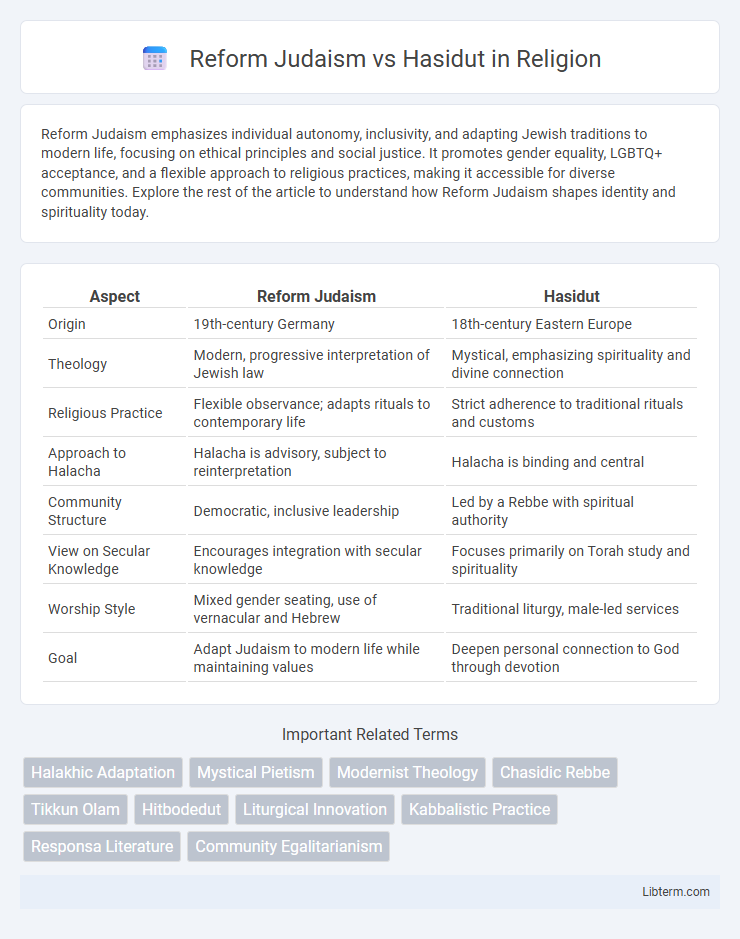Reform Judaism emphasizes individual autonomy, inclusivity, and adapting Jewish traditions to modern life, focusing on ethical principles and social justice. It promotes gender equality, LGBTQ+ acceptance, and a flexible approach to religious practices, making it accessible for diverse communities. Explore the rest of the article to understand how Reform Judaism shapes identity and spirituality today.
Table of Comparison
| Aspect | Reform Judaism | Hasidut |
|---|---|---|
| Origin | 19th-century Germany | 18th-century Eastern Europe |
| Theology | Modern, progressive interpretation of Jewish law | Mystical, emphasizing spirituality and divine connection |
| Religious Practice | Flexible observance; adapts rituals to contemporary life | Strict adherence to traditional rituals and customs |
| Approach to Halacha | Halacha is advisory, subject to reinterpretation | Halacha is binding and central |
| Community Structure | Democratic, inclusive leadership | Led by a Rebbe with spiritual authority |
| View on Secular Knowledge | Encourages integration with secular knowledge | Focuses primarily on Torah study and spirituality |
| Worship Style | Mixed gender seating, use of vernacular and Hebrew | Traditional liturgy, male-led services |
| Goal | Adapt Judaism to modern life while maintaining values | Deepen personal connection to God through devotion |
Introduction to Reform Judaism and Hasidut
Reform Judaism emerged in the 19th century as a movement seeking to modernize Jewish practice by emphasizing ethical monotheism and adapting rituals to contemporary life, often allowing for personalized worship and progressive interpretations of Jewish law. Hasidut, founded in the 18th century by Rabbi Israel Baal Shem Tov, emphasizes mysticism, joyful worship, and close spiritual leadership under a rebbe, promoting a deep emotional connection to God through traditional observance and communal life. Both movements reflect different responses to modernity within Judaism: Reform Judaism focusing on innovation and flexibility, while Hasidut reinforces spiritual depth and continuity through devotional fervor.
Historical Origins and Development
Reform Judaism originated in early 19th-century Germany as a response to modernity, emphasizing rationalism and adapting Jewish practices to contemporary life, with leaders like Rabbi Abraham Geiger advocating for liturgical changes and ethical monotheism. Hasidut emerged in the 18th century in Eastern Europe, founded by Rabbi Israel Baal Shem Tov, focusing on mysticism, spiritual joy, and the accessibility of God through prayer and devotion. While Reform Judaism sought to harmonize Judaism with Enlightenment values, Hasidut reinforced traditional piety and communal bonds, leading to divergent religious expressions within Judaism.
Core Beliefs and Doctrines
Reform Judaism emphasizes individual autonomy in interpreting Jewish law, prioritizing ethical principles and evolving religious practices to align with modern values. Hasidut centers on deep spiritual connection, mysticism, and adherence to traditional Halacha, with a strong focus on the leadership of a Rebbe and the importance of joy and prayer in daily life. Core beliefs in Reform promote inclusivity and social justice, while Hasidut maintains strict observance of commandments and mystical devotion as pathways to closeness with God.
Approaches to Jewish Law (Halacha)
Reform Judaism adopts a flexible approach to Jewish Law (Halacha), emphasizing individual autonomy and modern ethical values over strict adherence to traditional rituals and commandments. Hasidut, rooted in Orthodox Judaism, maintains rigorous observance of Halacha, integrating mystical spirituality and joyous practice within a framework of strict legal compliance. The divergence highlights Reform's adaptation to contemporary life versus Hasidut's commitment to preserving classical legal and spiritual traditions.
Worship Practices and Rituals
Reform Judaism emphasizes individualized worship with mixed-gender seating, vernacular prayers, and musical instruments, aiming for modern inclusivity and accessibility in rituals. Hasidut maintains traditional, Orthodox practices including separate seating, Hebrew prayers, and a strong emphasis on mystical and communal prayer experiences. These contrasting worship practices reflect Reform Judaism's adaptive approach versus Hasidut's preservation of historical and spiritual customs.
Synagogue Life and Prayer Styles
Reform Judaism synagogue life emphasizes inclusivity and adaptability, with prayer services often conducted in the vernacular and featuring mixed seating to foster community engagement. Hasidut maintains traditional synagogue practices, characterized by fervent, melodic prayers in Hebrew and separated seating to preserve spiritual focus. Prayer styles in Reform Judaism tend to be shorter and less structured, while Hasidut services are lengthy, repetitive, and designed to induce spiritual elevation through song and meditation.
Attitudes Toward Modernity and Secular Society
Reform Judaism embraces modernity and secular society by actively integrating contemporary values, emphasizing individual autonomy, and adapting religious practices to align with current social norms. Hasidut maintains a more traditional stance, often prioritizing spiritual experience and adherence to established customs, with cautious engagement with modern secular influences. The divergent approaches reflect Reform Judaism's openness to change versus Hasidut's focus on preserving religious continuity and community cohesion.
Gender Roles and Participation
Reform Judaism promotes gender equality by fully including women in religious leadership, ritual participation, and decision-making roles, embracing egalitarian prayer and mixed-gender seating. Hasidut, rooted in traditional Orthodox Judaism, maintains distinct gender roles with separate prayer spaces for men and women, limiting women's ritual participation and leadership while emphasizing spiritual roles within the home. These differences reflect broader theological views, with Reform Judaism advocating progressive values and Hasidut upholding traditional halakhic interpretations.
Community Structure and Leadership
Reform Judaism emphasizes a flexible community structure with egalitarian leadership roles often filled by rabbis, cantors, and lay members who promote inclusivity and individual choice. Hasidut maintains a hierarchical model centered on the Rebbe, a charismatic spiritual leader who embodies religious authority and provides guidance to tightly knit, obedient communities. This contrast reflects Reform Judaism's modern, decentralized approach versus Hasidut's traditional, centralized leadership deeply rooted in mystical teachings.
Contemporary Challenges and Future Directions
Reform Judaism faces contemporary challenges such as balancing modernization with tradition and addressing diverse congregational needs, while Hasidut grapples with maintaining spiritual fervor amid secular influences and youth engagement. Both movements explore future directions centered on inclusivity, digital innovation, and revitalizing religious education to sustain relevance in a rapidly changing world. Their evolving approaches highlight ongoing efforts to reconcile heritage with contemporary societal dynamics.
Reform Judaism Infographic

 libterm.com
libterm.com